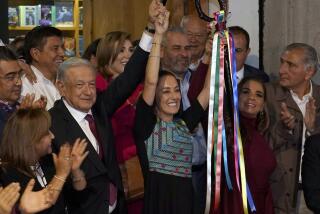MEXICO / PARTY POLITICS : PRI Searching for New Image : Group has faced unprecedented threats to its long hold over the government.
- Share via
MEXICO CITY — Over the next three days, the party that has ruled Mexico for 61 years will attempt to re-invent itself, at least enough to present a new face to voters in next year’s congressional elections.
The 8,500 delegates to the 14th National Convention of the Institutional Revolutionary Party, known as the PRI from its initials in Spanish, are charged with restoring the party’s slipping fortunes.
In the last two years, the PRI has faced unprecedented challenges to its authority, winning a presidential election by the narrowest margin in its history and losing its first gubernatorial race. State and local elections have resulted in violence as opponents angrily charged fraud.
Meanwhile, an economic reform program based on austerity has continued to erode the spending power of Mexicans. Union members, the foot soldiers of the PRI, have been among the hardest hit.
“The party has become an albatross around the government’s neck,” said Adrian LaJous, a political observer and former government official.
Party officials do not go that far but do acknowledge the need for change.
“We need far-reaching reforms,” Luis Donaldo Colosio, PRI executive committee president, told reporters earlier this week. “We need a new PRI for the new Mexican society.”
The question is whether those reforms can come from the convention that starts today.
“It’s just a show to make cosmetic changes,” said LaJous. “I don’t think it’s possible to have an official party and have it be independent of the government.”
Traditionally, the PRI has been the government’s vote-gathering machine, a broad coalition of labor unions, farm organizations and the so-called popular sector, anyone who did not fit into the other two categories. Party members channeled their complaints and their requests through their sector, or interest group, to the government.
Now, the PRI is trying to distinguish itself from the government. In Colosio’s words, “We want to give the party its own voice and initiative.”
One tactic being proposed is to orient the party more toward geographical regions, encouraging members to work in their region as well as their interest group.
“The party cannot stop being a party (made up) of organizations,” Colosio said. However, it can recognize regional differences, he said.
Colosio has also tried to broaden the appeal of the party, inviting entrepreneurs to join and issuing invitations to dissident party members to attend the convention.
That effort largely backfired as Fidel Velasquez, the 90-year-old leader of the labor movement and a party stalwart, made it clear that he did not welcome those groups.
Velasquez’s comments were an important factor in one dissident group’s decision not to attend.
“We all remember what happened at the last convention, when dissenting members were not allowed to speak,” said Ramiro De la Rosa, a member of the coordinating committee of the dissident group, called the Critical Current.
The last convention’s dissidents were eventually forced out of the party and went on to form the core of the Democratic Revolutionary Party (PRD), which has presented major electoral challenges to the PRI over the last two years. Many Mexicans believe that the dissidents, led by Cuauhtemoc Cardenas, actually won the 1988 presidential election.
The remaining dissidents do not want to be forced out of the PRI, especially at a convention that they do not believe will produce any real reforms.
“They want to come out of this convention looking as if they have made the party more democratic,” said De la Rosa. “But their worry is not democracy, it is winning the next election.”
More to Read
Sign up for Essential California
The most important California stories and recommendations in your inbox every morning.
You may occasionally receive promotional content from the Los Angeles Times.













